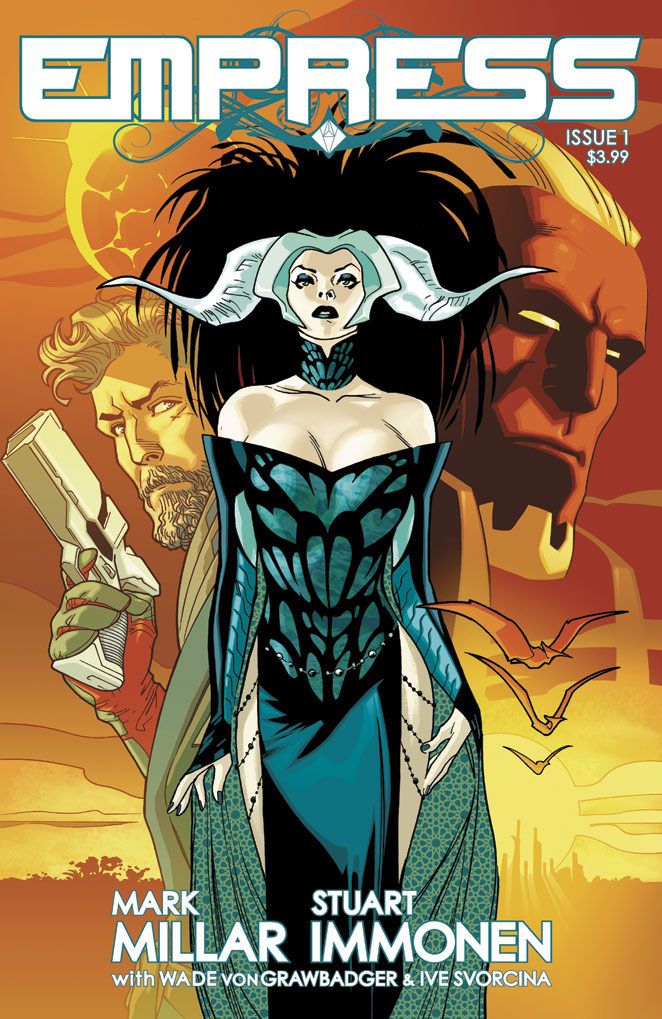Coming from the creative team like Mark Millar and Stuart Immonen, "Empress" #1 was always unlikely to disappoint. The series opener is incredibly competent, steamrolling through the necessary setup without feeling rushed or broadly sketched. Empress Emporia, her family and her plight are all introduced with energy and style, and I took real delight in seeing Immonen draw exploding spaceships and dinosaur-riding gladiators. However, in a crowded science fiction landscape, the world-building and character work of "Empress" fail to stand out. This issue is relentlessly enjoyable, but it lacks a unique point-of-view to take it from "good read" to "must-read."
Millar & Immonen Promise Grounded But Relentless Sci-Fi Action In "Empress"
Above all, the plot moves with effortless efficiency. "Empress" #1 opens with a public spectacle of King Morax's tyranny, which he creepily devotes to his wife, Emporia. Immonen gets to wow the reader with striking, scale-setting panels, and Emporia's dilemma is clearly, flashily demonstrated for the reader. From there, Millar launches Emporia, her bodyguard Dane and her children into escape mode. "Time is not our friend, ma'am," warns Dane, and Millar matches his pace to their mad dash. Immonen's panels also get closer and more crowded, heightening the sense of chaos and fast motion. As a reader, I just coasted through this story.
A huge part of the credit for that goes to Immonen and inker Wade von Grawbadger. I'm never lost on an Immonen page, and the clarity of his panels is indispensable in a story that moves this quickly. He's a master of perspective, weaving necessary establishing shots into the action in a way that never left me lost. The art also works on an emotional level; Immonen's expressive faces and jaunty body language are full of feeling and life. Grawbadger also gives the lines the right weight, producing some of the smoothest art I've seen in a while.
As far as the creativity and character designs go, there are certainly enough T-rexes, armored aliens and galactic warships to entertain the eye. However, the world of "Empress" doesn't feel particularly new. The ships and arenas are similar to worlds I've seen before, and colorist Ive Svorcina's heavy use of orange and blue doesn't always help. While it most often looks modern and neat, sometimes the red-orange overwhelms, and the panel looks too much like an old-school action flick.
In addition, the reader doesn't get too much from Emporia's perspective. She's clearly the protagonist, but she isn't quite the point-of-view character. Her lines -- like "I can't have my kids growing up in this madness" and "I'm fine. The armor took the brunt of it" -- are quite matter-of-fact. There's something appealing about such a practical female protagonist, but I was left wanting a little more emotion or personality to dig into. It's pretty easy to root for characters who are escaping an evil dictator, but I need a reason to invest in Emporia's success as a person. A series needs to provide a memorable character or a memorable world, but "Empress" #1 doesn't quite have either.
All told, "Empress" is a slick read that falls just short of wowing me. Cool concepts abound, but they aren't tied together with a unified mood, and I'm not left eager to dive back into this world. It's hard not to enjoy "Empress" #1 -- a brisk, beautiful first issue that moves expertly -- but it's just as hard to say what makes it special.

